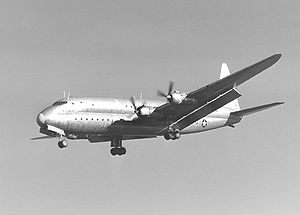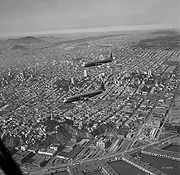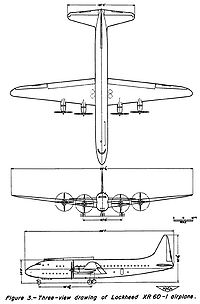
Lockheed R6V
Encyclopedia
The Lockheed R6V Constitution was a large, propeller-driven, double-decker transport aircraft developed in the 1940s by Lockheed
as a long-range, high capacity transport and airliner
for the U.S. Navy and Pan American Airways. (The Constitutions were identified as R6O until 1950.) Only two of the aircraft were ever built, both prototypes. Although these two planes went into service with the Navy, the Constitution design ultimately proved underpowered and too large for practical airline use at the time. The Constitution remains the largest fixed-wing aircraft
type ever operated by the U.S. Navy.
 The Lockheed Constitution began life in 1942 as a joint study by the U.S. Navy, Pan Am
The Lockheed Constitution began life in 1942 as a joint study by the U.S. Navy, Pan Am
, and Lockheed. The design requirements, initially designated Lockheed Model 89, called for a large transport aircraft to improve upon the Navy's fleet of flying boat
s. Pan Am was involved in the study because such an aircraft had potential use as a commercial airliner. This transport would carry 17,500 pounds of cargo 5000 miles (8,046.7 km) at a cruising altitude of 25000 feet (7,620 m) and a speed greater than 250 mi/h. The aircraft would be fully pressurized and large enough so that most major components could be accessed and possibly repaired in flight. For instance, tunnels led through the thick wings to all four engines.
The aircraft was designed by a team of engineers led by Willis Hawkins
and W.A. Pulver of Lockheed and Commander E. L. Simpson, Jr. of the Navy. The name Constitution was given to the project by Lockheed president Robert E. Gross.
The Constitution design had a "double bubble" fuselage, the cross section of which was a "figure eight". This unorthodox design, originally created in 1937 by Curtiss-Wright
's chief aircraft designer George A. Page Jr. and first introduced with the Curtiss C-46 Commando, utilized the structural advantages of a cylinder for cabin pressurization
, without the wasted space that would result from a single large cylinder of the same volume.
The original contract from the Bureau of Aeronautics
called for 50 Constitutions for a total price tag of $111,250,000. On VJ Day, however, the contract was scaled back to $27,000,000 for only two aircraft.
 The first Constitution, BuNo 85163, was built in the summer of 1946 at the Lockheed plant in Burbank, California
The first Constitution, BuNo 85163, was built in the summer of 1946 at the Lockheed plant in Burbank, California
. Due to the aircraft's large size—the tail towered 50 feet (15.2 m)—Lockheed had to build a special hangar for final assembly. The hangar, Lockheed-California's Building 309, measured 408 ft (124.4 m) long, 302 ft (92 m) wide, and the equivalent of six stories tall. The footprint of the hangar covered 4 acres (16,187.4 m²). It cost $1,250,000.
The R6O made its first flight on 9 November 1946, powered by interim 3,000 hp R-4360-18 radials. Joe Towle and Tony LeVier
flew the aircraft on a leisurely course to Muroc Air Force Base. Once there, the aircraft underwent a carefully documented test program. At this time, electronic data recording technology was not well developed, so instrument readings were recorded by a movie camera pointed at the instrument panel. Additional movie cameras were carried to record test results.
The first Constitution made a nonstop flight from Moffett Field to NAS Patuxent River on 25 July 1948, a distance of 2460 mi (3,959 km). The pilot for the flight was Commander William Collins (USN) and the copilot was Roy Wimmer, Lockheed engineering test pilot. Four days later, the ship was formally christened by Mrs. John L. Sullivan, wife of the Secretary of the Navy, at Washington National Airport.
The first test flights revealed that the aircraft was underpowered so the engines were changed for 3,500 hp (with water injection) R-4360-22-W engines. The R6O also tested assisted takeoffs
with six rockets mounted on the rear of the fuselage. At full gross weight, the rockets shortened the takeoff run by 24%.
Ship No. 1 was delivered to Navy Transport Squadron VR-44, based at Naval Air Station Alameda
, on 2 February 1949. Both it and its sister ship, Ship No. 2 (which followed six months later), flew the route between California and Hawaii
, approximately 2460 mi (3,959 km).
 The second Constitution, BuNo 85164, first flew on 9 June 1948. Unlike Ship No. 1. the upper deck was fully furnished as a luxury passenger transport, with accommodations for 92 passengers and 12 crew. Accommodations on the upper deck of the first Constitution were decidedly more spartan. On the rear of the forward bulkhead, in front of the spiral staircase leading to the lower deck, there was a permanent display case containing a scale model of the original USS Constitution
The second Constitution, BuNo 85164, first flew on 9 June 1948. Unlike Ship No. 1. the upper deck was fully furnished as a luxury passenger transport, with accommodations for 92 passengers and 12 crew. Accommodations on the upper deck of the first Constitution were decidedly more spartan. On the rear of the forward bulkhead, in front of the spiral staircase leading to the lower deck, there was a permanent display case containing a scale model of the original USS Constitution
sailing ship.
The lower deck had 7373 cubic feet (208.8 m³) of cargo space, and it was loaded by an electrical hoist. The lower deck could also be converted to seat an additional 76 passengers.
The second Constitution, like its predecessor, also made a non-stop transcontinental flight. On 3 February 1949, the aircraft flew 74 members of the press from Moffett Field to Washington National Airport. At the time, this was the largest number of people flown across the United States in a single flight. This flight inaugurated six months of regular service between Washington, D.C. and San Francisco.
In the early 1950s, Ship No. 2 made a Navy recruiting tour of 19 cities. The side of the fuselage proudly advertised "Your Navy—Air And Sea." Some 546,000 toured the aircraft's interior.
The Navy operated the two Constitutions through the end of the 1940s and into the 1950s. By 1949, however, the Navy announced that it could no longer afford to operate them, and offered them to airlines on a five-year lease. There was no interest from airlines in using the Constitutions (the airline version was named the Model 189), so the Navy retired both aircraft in 1953. They went into storage at Litchfield Park, Arizona
in 1955. Both aircraft and 13 spare engines were sold for $97,785. Lockheed proposed the Model 389 and Model 489 airliners based on the Constitution, which would have accommodated up to 169 passengers. Neither of these "paper" projects received much interest from civil operators.
The first Constitution was brought to Las Vegas
, where it served as an enormous billboard for Alamo Airways, before being scrapped by Howard Hughes
when he acquired the property. The second Constitution was flown to Opa-Locka Airport
, Florida, where it was stored on the airfield before being towed to a scrap yard. There it was set on fire by vandals, completing its destruction in 1979.

Lockheed Corporation
The Lockheed Corporation was an American aerospace company. Lockheed was founded in 1912 and later merged with Martin Marietta to form Lockheed Martin in 1995.-Origins:...
as a long-range, high capacity transport and airliner
Airliner
An airliner is a large fixed-wing aircraft for transporting passengers and cargo. Such aircraft are operated by airlines. Although the definition of an airliner can vary from country to country, an airliner is typically defined as an aircraft intended for carrying multiple passengers in commercial...
for the U.S. Navy and Pan American Airways. (The Constitutions were identified as R6O until 1950.) Only two of the aircraft were ever built, both prototypes. Although these two planes went into service with the Navy, the Constitution design ultimately proved underpowered and too large for practical airline use at the time. The Constitution remains the largest fixed-wing aircraft
Fixed-wing aircraft
A fixed-wing aircraft is an aircraft capable of flight using wings that generate lift due to the vehicle's forward airspeed. Fixed-wing aircraft are distinct from rotary-wing aircraft in which wings rotate about a fixed mast and ornithopters in which lift is generated by flapping wings.A powered...
type ever operated by the U.S. Navy.
Design and development

Pan American World Airways
Pan American World Airways, commonly known as Pan Am, was the principal and largest international air carrier in the United States from 1927 until its collapse on December 4, 1991...
, and Lockheed. The design requirements, initially designated Lockheed Model 89, called for a large transport aircraft to improve upon the Navy's fleet of flying boat
Flying boat
A flying boat is a fixed-winged seaplane with a hull, allowing it to land on water. It differs from a float plane as it uses a purpose-designed fuselage which can float, granting the aircraft buoyancy. Flying boats may be stabilized by under-wing floats or by wing-like projections from the fuselage...
s. Pan Am was involved in the study because such an aircraft had potential use as a commercial airliner. This transport would carry 17,500 pounds of cargo 5000 miles (8,046.7 km) at a cruising altitude of 25000 feet (7,620 m) and a speed greater than 250 mi/h. The aircraft would be fully pressurized and large enough so that most major components could be accessed and possibly repaired in flight. For instance, tunnels led through the thick wings to all four engines.
The aircraft was designed by a team of engineers led by Willis Hawkins
Willis Hawkins
Willis M. Hawkins was an aeronautical engineer for Lockheed for more than fifty years. He was hired to the company in 1937, immediately after receiving his bachelor's degree in aeronautical engineering from the University of Michigan...
and W.A. Pulver of Lockheed and Commander E. L. Simpson, Jr. of the Navy. The name Constitution was given to the project by Lockheed president Robert E. Gross.
The Constitution design had a "double bubble" fuselage, the cross section of which was a "figure eight". This unorthodox design, originally created in 1937 by Curtiss-Wright
Curtiss-Wright
The Curtiss-Wright Corporation was the largest aircraft manufacturer in the United States at the end of World War II, but has evolved to largely become a component manufacturer, specializing in actuators, aircraft controls, valves, and metalworking....
's chief aircraft designer George A. Page Jr. and first introduced with the Curtiss C-46 Commando, utilized the structural advantages of a cylinder for cabin pressurization
Cabin pressurization
Cabin pressurization is the pumping of compressed air into an aircraft cabin to maintain a safe and comfortable environment for crew and passengers when flying at altitude.-Need for cabin pressurization:...
, without the wasted space that would result from a single large cylinder of the same volume.
The original contract from the Bureau of Aeronautics
Bureau of Aeronautics
The Bureau of Aeronautics was the U.S. Navy's material-support organization for Naval Aviation from 1921 to 1959. The bureau had "cognizance" for the design, procurement, and support of Naval aircraft and related systems...
called for 50 Constitutions for a total price tag of $111,250,000. On VJ Day, however, the contract was scaled back to $27,000,000 for only two aircraft.
Ship No. 1

Burbank, California
Burbank is a city in Los Angeles County in Southern California, United States, north of downtown Los Angeles. The estimated population in 2010 was 103,340....
. Due to the aircraft's large size—the tail towered 50 feet (15.2 m)—Lockheed had to build a special hangar for final assembly. The hangar, Lockheed-California's Building 309, measured 408 ft (124.4 m) long, 302 ft (92 m) wide, and the equivalent of six stories tall. The footprint of the hangar covered 4 acres (16,187.4 m²). It cost $1,250,000.
The R6O made its first flight on 9 November 1946, powered by interim 3,000 hp R-4360-18 radials. Joe Towle and Tony LeVier
Tony LeVier
Anthony W. "Tony" LeVier was an air racer and test pilot for the Lockheed Corporation from the 1940s to the 1970s.- Early life :...
flew the aircraft on a leisurely course to Muroc Air Force Base. Once there, the aircraft underwent a carefully documented test program. At this time, electronic data recording technology was not well developed, so instrument readings were recorded by a movie camera pointed at the instrument panel. Additional movie cameras were carried to record test results.
The first Constitution made a nonstop flight from Moffett Field to NAS Patuxent River on 25 July 1948, a distance of 2460 mi (3,959 km). The pilot for the flight was Commander William Collins (USN) and the copilot was Roy Wimmer, Lockheed engineering test pilot. Four days later, the ship was formally christened by Mrs. John L. Sullivan, wife of the Secretary of the Navy, at Washington National Airport.
The first test flights revealed that the aircraft was underpowered so the engines were changed for 3,500 hp (with water injection) R-4360-22-W engines. The R6O also tested assisted takeoffs
JATO
JATO is an acronym for jet-fuel assisted take off. It is a system for helping overloaded aircraft into the air by providing additional thrust in the form of small rockets....
with six rockets mounted on the rear of the fuselage. At full gross weight, the rockets shortened the takeoff run by 24%.
Ship No. 1 was delivered to Navy Transport Squadron VR-44, based at Naval Air Station Alameda
Naval Air Station Alameda
Naval Air Station Alameda was a United States Navy Naval Air Station in Alameda, California, on San Francisco Bay.NAS Alameda had two runways: 07-25 and 13-31...
, on 2 February 1949. Both it and its sister ship, Ship No. 2 (which followed six months later), flew the route between California and Hawaii
Hawaii
Hawaii is the newest of the 50 U.S. states , and is the only U.S. state made up entirely of islands. It is the northernmost island group in Polynesia, occupying most of an archipelago in the central Pacific Ocean, southwest of the continental United States, southeast of Japan, and northeast of...
, approximately 2460 mi (3,959 km).
Ship No. 2

USS Constitution
USS Constitution is a wooden-hulled, three-masted heavy frigate of the United States Navy. Named by President George Washington after the Constitution of the United States of America, she is the world's oldest floating commissioned naval vessel...
sailing ship.
The lower deck had 7373 cubic feet (208.8 m³) of cargo space, and it was loaded by an electrical hoist. The lower deck could also be converted to seat an additional 76 passengers.
The second Constitution, like its predecessor, also made a non-stop transcontinental flight. On 3 February 1949, the aircraft flew 74 members of the press from Moffett Field to Washington National Airport. At the time, this was the largest number of people flown across the United States in a single flight. This flight inaugurated six months of regular service between Washington, D.C. and San Francisco.
In the early 1950s, Ship No. 2 made a Navy recruiting tour of 19 cities. The side of the fuselage proudly advertised "Your Navy—Air And Sea." Some 546,000 toured the aircraft's interior.
Final disposition
The Constitution had operational difficulties which prevented it from meeting its original design objectives. The large airframe needed more power than the four Pratt & Whitney R-4360s could deliver. The engines also had cooling problems. While this could be compensated for by flying with engine cooling gills partially open, it increased drag and therefore decreased the overall range.The Navy operated the two Constitutions through the end of the 1940s and into the 1950s. By 1949, however, the Navy announced that it could no longer afford to operate them, and offered them to airlines on a five-year lease. There was no interest from airlines in using the Constitutions (the airline version was named the Model 189), so the Navy retired both aircraft in 1953. They went into storage at Litchfield Park, Arizona
Litchfield Park, Arizona
Litchfield Park is a city in Maricopa County, Arizona, United States. In 2010 it had a population of 5,476.-History:The town of Litchfield Park is named for its founder, Paul Weeks Litchfield...
in 1955. Both aircraft and 13 spare engines were sold for $97,785. Lockheed proposed the Model 389 and Model 489 airliners based on the Constitution, which would have accommodated up to 169 passengers. Neither of these "paper" projects received much interest from civil operators.
The first Constitution was brought to Las Vegas
Las Vegas, Nevada
Las Vegas is the most populous city in the U.S. state of Nevada and is also the county seat of Clark County, Nevada. Las Vegas is an internationally renowned major resort city for gambling, shopping, and fine dining. The city bills itself as The Entertainment Capital of the World, and is famous...
, where it served as an enormous billboard for Alamo Airways, before being scrapped by Howard Hughes
Howard Hughes
Howard Robard Hughes, Jr. was an American business magnate, investor, aviator, engineer, film producer, director, and philanthropist. He was one of the wealthiest people in the world...
when he acquired the property. The second Constitution was flown to Opa-Locka Airport
Opa-locka Airport
Opa-locka Airport , also known as Opa-locka Executive Airport, is a general aviation airport and joint civil-military airfield 10 miles north of Downtown Miami, primarily in metropolitan Miami, Florida, United States, with a portion within the city proper of Opa-locka.The airport's control tower...
, Florida, where it was stored on the airfield before being towed to a scrap yard. There it was set on fire by vandals, completing its destruction in 1979.
Specifications (R6V BuNo 85164)


